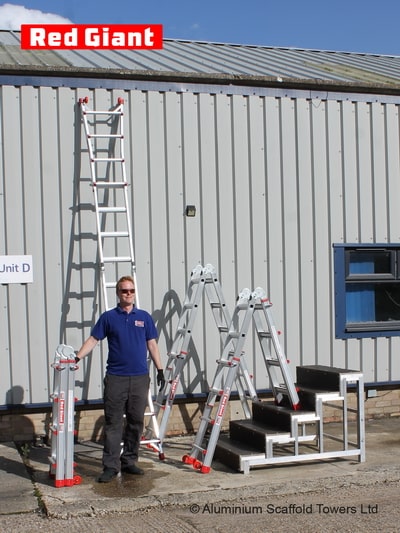No products in the basket.
Blog
How to Choose the Right Ladder Height for Your Project

1. Introduction
You’ve got the project planned, materials gathered, and motivation high — but once you reach the ladder aisle, the choices can be overwhelming. A 4-foot step ladder? A 24-foot extension ladder? Something in between?
Choosing the wrong ladder height isn’t a small inconvenience — it’s a major safety risk. A ladder that’s too short forces you to overstretch dangerously, while one that’s too tall can be unwieldy, unstable, or difficult to store.
This complete guide will help you confidently choose the right ladder height for any job — whether you’re painting ceilings, cleaning gutters, or accessing a two-storey roof — while keeping safety and efficiency in mind.
2. Why Ladder Height Matters
Choosing the right ladder height is essential for both safety and efficiency.
2.1 🚫 Safety
Using a ladder that’s too short can tempt you to overreach, throwing off your balance and increasing the risk of tipping sideways. Conversely, an overly tall ladder may be too steep or unstable for shorter jobs, creating a different kind of hazard.
2.2 💪 Efficiency
The correct height allows you to work with your arms in a natural, comfortable position — minimising strain, improving accuracy, and helping you stay productive for longer periods.
2.3 🧱 Ladder Longevity
Operating within the ladder’s rated height and weight limits not only protects you but also reduces wear and tear, extending its lifespan.
The Health and Safety Executive (HSE) in the UK recommends using a ladder that allows you to work comfortably —
- ❌ Don’t stand and work on the top three steps (including a step forming the very top of the stepladder) of a step ladder unless there is a suitable handhold and always maintaining three points of contact.
- ❌ Don’t work off the top three rungs of a leaning ladder (eg. Extension ladder). Try to make sure that the ladder extends at least 1 metre or three rungs above where you are working.
- ✔️ Always maintaining three points of contact.
According to the World Health Organization, falls from height are among the leading causes of accidental injury and death worldwide — and a significant portion involve ladders.

3. Understanding Ladder Height Terminology
Different manufacturers use slightly different terms. Here’s what they mean:
1️⃣ Ladder Length (or Extended Length)
The total physical length of the ladder when fully extended. This is not the same as the safe working height — never stand on the top rungs or steps.
2️⃣ Maximum Safe Standing Height
The highest rung or step you can safely stand on:
- 🪜 Step ladders: approximately four steps down from the top (including the top)
- 🧩 Extension ladders: approximately four rungs down from the top
- ⚙️ Platform step ladders: you can safely stand on the platform
3️⃣ Working or Reach Height
The approximate height your hands can reach when standing safely — usually around 1.5 to 2 metres above the standing height.
4️⃣ Platform Height (for podium, platform step, or scaffold ladders)
The actual height of the standing surface. Add your own height to estimate the working height.
4. How to Calculate the Right Ladder Height
Step 1: Identify Your Task
- 🏠 Interior work (painting ceilings, hanging curtains): up to 3 m
- 🌿 Garden and hedge trimming: up to 3–4 m
- 🧽 Window cleaning or gutter work: 4–6 m
- 🧰 Roof access or maintenance: 6–9 m or more
Step 2: Measure the Height You Need to Reach
Estimate the maximum height you’ll need to reach — such as the top of a window, ceiling, or gutter.
Step 3: Subtract Your Height
Subtract your own height plus arm reach (about 2 m total) from that measurement to find your required ladder standing height.
Step 4: Choose a Ladder Type
| Ladder Type | Ladder Length | Max Standing Height | Approx. Working Height |
|---|---|---|---|
| Step Ladder | 1.2–3.6 m | 0.8–3.2 m | +2 m (your reach) |
| Extension Ladder | 3.0–10.0 m | 1 m less than total | +2 m (your reach) |
| Combination Ladder | 2.0–6.0 m | Depends on setup | +2 m (your reach) |
| Telescopic Ladder | 2.0–5.0 m | 0.8–4.0 m | +2 m (your reach) |
5. Step Ladders: Ideal for Indoor Tasks
Step ladders are self-supporting and perfect for indoor or low-level jobs.
Best for:
- 🎨 Painting and decorating
- 💡 Changing light fittings
- 🪟 Cleaning or hanging curtains
📏 Choosing the Right Height:
Don’t stand and work on the top three steps. Your working height is typically 2 m above the max safe standing step.
Example: A 1 m max safe standing step gives a working height of around 3 m.
6. Extension Ladders: Best for Outdoor Height Work
Extension ladders are ideal for roofs, gutters, or high exterior walls.
Best for:
- 🏡 Gutter cleaning
- 🔧 Roof inspections and repairs
- 🎄 Hanging outdoor decorations
📏 Choosing the Right Height:
Your ladder should extend at least 1 m or three rungs above the roofline or access point.
Maintain a 1:4 angle (one unit out for every four up).
Example:
To reach a 6 m roof:
Diagonal length = 6 × 1.03 = 6.2 m → add 1 m above roofline = 7.2 m total length.
Choose an extension ladder of at least 7.2 m to allow for overlap and a safe standing distance.
7. Multi-Purpose and Combination Ladders
Multi-Purpose Ladders and Combination Ladders convert between step, extension, stair or platform modes — ideal for versatile jobs.
Best for:
- 🏗️ Tradespeople or DIYers with varied projects
- 🔧 Use on stairs or uneven ground
- 🪜 Compact storage and easy transport
👉 The Loyal Telescopic Multi-Purpose Ladder functions as a step ladder, extension ladder, stair ladder, and — with an optional adaptor — converts into two secure trestles.
8. Telescopic Ladders: Compact but Capable
Telescopic ladders collapse for easy storage but still reach impressive heights.
Best for:
- 🧰 Homeowners and mobile professionals
- 🚐 Van or car boot storage
- 🏠 Occasional indoor/outdoor jobs
⚠️ Safety Tip:
Always extend and lock each section fully before use. Never climb a partially extended ladder.
9. Working Height vs. Ladder Height — Quick Guide
| Task | Height to Reach | Ideal Ladder Type | Recommended Ladder Height |
|---|---|---|---|
| Change a ceiling light | 2.4 m | Step ladder | 1.0–1.5 m |
| Paint a stairwell wall | 3.5–4 m | Combination ladder | 2.5–3.0 m |
| Clean bungalow gutters | 3.0 m | Extension ladder | 4.0–5.0 m |
| Clean two-storey gutters | 5.5–6.0 m | Extension ladder | 7.5–8.5 m |
| Access a two-storey roof | 6.0–7.0 m | Extension ladder | 8.5–9.5 m |
10. Ladder Safety Guidelines (HSE-Based)
Whatever ladder you choose, safety comes first. The HSE warns that improper ladder use is one of the top causes of workplace falls.
Follow these rules:
- 👣 Maintain three points of contact.
- 🧱 Set ladders at a 75° angle (1:4 ratio) for leaning ladders.
- 🚫 Never stand on the top three rungs.
- ⚙️ Inspect before use for damage.
- 🪜 Use stabilisers or footing mats on smooth surfaces.
- ⛔ Don’t lean sideways or overreach.
- ☔ Avoid using ladders in wet or windy weather.

11. Final Tips for Choosing the Right Ladder
🪜 Ladder Material:
- 🪣 Aluminium — lightweight and rust-resistant
- 🧰 Fibreglass — non-conductive, ideal for electrical work
- 🏗️ Steel — heavy but extremely durable
- 🪵 Wood — traditional, non-conductive when dry, but heavy and less durable
⚖️ Weight Rating:
The safe working weight for ladders certified under the EN131 standard (Professional and Non-Professional) is a maximum total load of 150 kg. This includes the weight of the user, tools, equipment, and any materials being used on the ladder.
🚛 Portability:
For frequent transport, consider a telescopic or folding model.
🏗️ Frequency of Use:
For professional or daily use, choose EN131-Professional that meets UK and EU safety standards.
12. Where to Buy Quality Ladders in the UK
For high-quality ladders, visit
👉 Aluminium Scaffold Towers — specialists in ladders, scaffold towers, and access equipment across the UK.
They stock:
- 🪜 Step ladders in multiple heights
- 🧱 Extension and combination ladders
- ⚙️ Telescopic multi-purpose ladders
- 📏 Fibreglass ladders
- 🚀 EN131 professional-grade models
13. Key Takeaways
- 🎯 The right ladder height keeps you safe, stable, and efficient.
- 📏 Always calculate your working height (reach + standing height).
- 🚫 Never stand on the top 3 rungs or steps.
- 🧱 Match the ladder type to the task.
- 🛠️ Choose certified UK-standard equipment for maximum safety.
14. Ready to Work Safely and Confidently?
Whether you’re repainting a ceiling or accessing a roofline, the right ladder makes all the difference.
Get your perfect fit from Aluminium Scaffold Towers — and climb with confidence, every time.
15. Conclusion: Safety Reaches New Heights with the Right Ladder
Choosing the right ladder height is a simple yet profound act of planning that pays dividends in safety, comfort, and project success. By understanding the difference between a ladder’s height and its safe working reach, and by applying the straightforward calculations we’ve outlined, you can banish the guesswork forever.
Don’t fall into the trap of “making do” with a ladder that’s almost the right size. Investing in the correctly sized ladder—or knowing which one to rent—is an investment in your well-being. Now that you’re armed with this knowledge, you can confidently tackle those high-up projects, knowing you have a solid foundation beneath you.
Ready to tackle your next project? Use this guide as your reference, and always remember: when in doubt, choose the slightly taller ladder for a safer, more comfortable working experience.
Further reading:
Explore more ladders and towers at Aluminium Scaffold Towers UK.
Understand safety markings: Tower Safety Markings Explained.
Common Ladder Mistakes to Avoid





